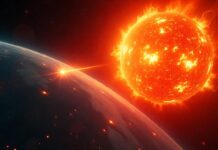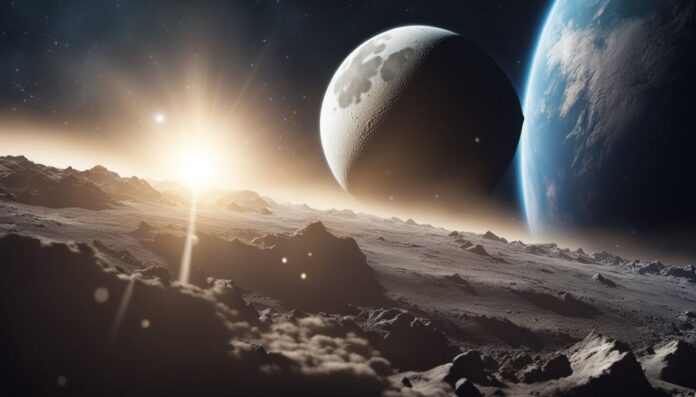
The Moon is a constant presence in our sky, but have you ever wondered what would happen if it were to crash into Earth?
The sole idea of a celestial body colliding with our planet may seem silly but it is an interesting thought experiment.
However, this would not be the only time some planet hit the Earth.
Namely, as we’ve written in our article ‘What If Theia Never Hit Earth,’ according to the giant-impact hypothesis, a planet the size of Mars apparently collided with Earth 4.5 billion years ago.
And so, using that analogy, in this article will explore the potential consequences of the Moon hitting the Earth and what it would mean for life on Earth.
Firstly, it’s important to understand the size and mass of the Moon.
It’s about one-quarter the size of Earth and has a mass approximately 1/80th of our planet’s.
And while this may look like tiny compared to Earth, the impact of the Moon crashing into Earth would be absolutely catastrophic.
Namely, everybody heard about the “famous” asteroid hitting the Earth 66 million years ago causing mass extinctions around the globe, and most notably destroying all dinosaurs.
This asteroid is estimated to have been approximately 10 to 15 kilometers (6 to 9 miles) in diameter.
In contrast, the Moon has a diameter of about 3,474.8 kilometers (2,159.2 miles).
To put this into perspective:
The asteroid that struck Earth during the dinosaur extinction event was extremely small compared to the Moon. It would fit within an ultra small fraction of the Moon’s diameter.
The Moon’s mass is significantly greater than that of the asteroid. The Moon’s mass is approximately 7.35 x 10^22 kilograms. That’s 7 sextillion, 350 quintillion kilograms
So, the mass of the Moon is approximately 11.85 million times larger than the mass of the asteroid that hit the dinosaurs.
And so, if a “tiny” asteroid caused a mass extinction event on Earth, then we can only imagine what would happen if a celestial body with 11.85 million times larger mass crashed into Earth.
So, let’s explore all potential consequences.
First, let’s see what could cause such a massive crash.
Interesting fact: The Moon is slowly moving away from Earth at a rate of about 1 inch per year. This means that in around 50 billion years, it will have drifted too far away to have any effect on our planet.
What Could Cause the Moon to Crash?
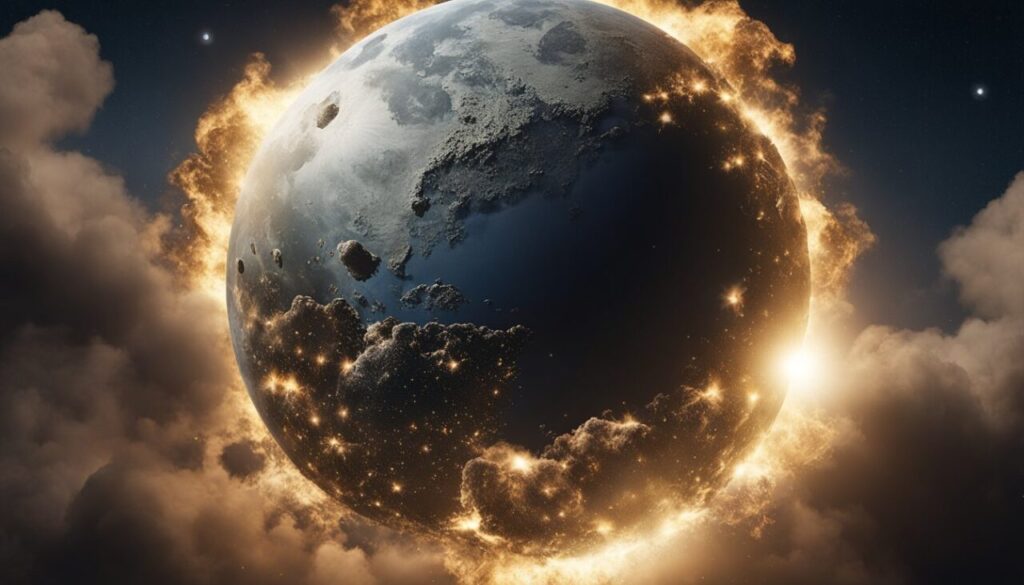
There are several factors that could hypothetically cause the moon to crash into the Earth, including:
- Gravitational pull: The moon’s orbit around the Earth is maintained by the gravitational pull between the two celestial bodies. If the moon were to come too close to the Earth, the gravitational pull could become so strong that the moon would be pulled out of its orbit and crash into the Earth.
- Change in Earth’s rotation: The Earth’s rotation is what creates the centrifugal force that keeps the moon in its orbit. If the Earth’s rotation were to slow down or speed up significantly, it could affect the moon’s orbit and cause it to crash into the Earth.
- Collision with another celestial body: While the chances of the moon colliding with another celestial body are slim, it is still a possibility. If the moon were to collide with a large asteroid or another planet, it could be knocked out of its orbit and crash into the Earth.
However, all those factors are purely hypothetical and highly unlikely. Namely, for this to happen, the universe (and the moon) would need to break numerous physical laws.
For example, here are the top 10 physical laws that would need to break in order for the moon to even have a chance to collide with Earth:
- Conservation of Angular Momentum: This law says that if something is spinning or moving in a circle, it will keep doing so unless something else interferes. For the Moon to hit Earth, its circular motion around Earth would need to be abruptly stopped or reversed.
- Conservation of Energy: This law says that energy can’t just appear out of nowhere or disappear into nothingness. It always has to go somewhere or transform into something else. For the Moon to collide with Earth, its energy of motion (kinetic energy) would need to vanish or be redirected against the usual rules.
- Newton’s Laws of Motion: These are the basic rules governing how things move. One of them says that unless something pushes or pulls on an object, it will keep doing what it’s doing—moving or standing still. For the Moon to crash into Earth, something huge and unprecedented would need to push or pull it out of its regular orbit.
- Gravitational Force: This is the pull between two objects with mass, like Earth and the Moon. It’s what keeps the Moon in orbit around Earth. For the Moon to collide with Earth, something would need to overcome or disrupt this pull, allowing the Moon to fall toward Earth.
- Conservation of Linear Momentum: This law states that if something is moving in a straight line, it will keep moving that way unless acted upon by an outside force. For the Moon to crash into Earth, its straight-line motion towards Earth would need to be abruptly changed, which goes against this law.
- Conservation of Mass-Energy: This principle says that the total amount of matter and energy in the universe stays the same over time. For the Moon to collide with Earth, there would be a huge release of energy that violates this principle unless new energy is suddenly introduced or the existing energy is made to disappear.
- General Theory of Relativity: This theory explains how gravity works on large scales, like the interactions between planets and stars. For the Moon to hit Earth, our understanding of how gravity behaves in extreme circumstances would likely need to be revised.
- Conservation of Mass: This rule says that matter can’t just vanish into thin air or appear out of nowhere. For the Moon to collide with Earth, some of its mass would need to disappear or new mass would need to be created, which contradicts this principle.
- Laws of Thermodynamics: These are rules about how energy moves and changes form. For the Moon to hit Earth, there would need to be a transfer or transformation of energy in ways that don’t follow these rules.
- Conservation of Charge: This principle says that electric charge can’t be created or destroyed, only transferred between objects. While not directly related to the scenario, any violation of this principle would challenge our understanding of fundamental physics.Interesting huh? So many things (laws) keeping everything in order and together. Nonetheless, if it were to happen, what could be the potential speed of the crash? Let’s see.
Potential Speed of Crash?
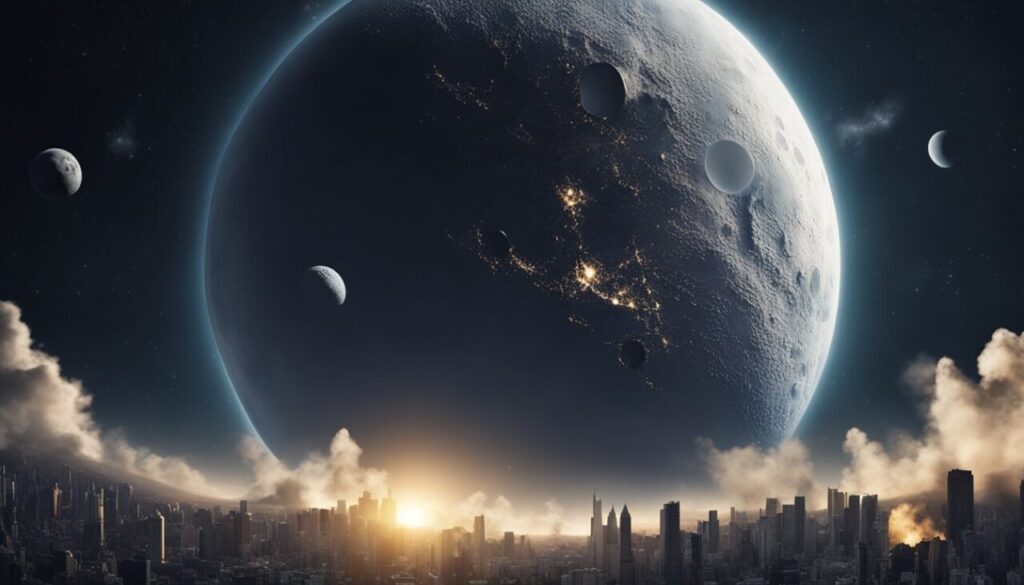
If the Moon were to crash into Earth, the speed of the impact would be unimaginable. Namely, the Moon orbits Earth at an average speed of 2,288 miles per hour (3,683 kilometers per hour).
However, in the hypothetical scenario of the Moon colliding with Earth, it would most likely be traveling at a much higher speed. The exact speed of the impact would depend on numerous factors.
Let’s try to calculate those:
- First, let’s assume that the Moon completely loses all its orbital velocity and falls directly toward Earth from its current position in space.
- We’ll calculate the acceleration due to gravity acting on the Moon as it falls towards Earth. On Earth’s surface, the acceleration due to gravity is approximately 9.8 m/s2
- Next, we’ll calculate the time it takes for the Moon to fall from its current position to the surface of Earth. This will depend on the distance between the Moon and Earth at the time of impact.
- Finally, we’ll use the formula for constant acceleration to calculate the final impact velocity of the Moon when it reaches the surface of Earth.
Let’s assume a distance of 384,400 kilometers between the Moon and Earth, which is the average distance between them.
Using the formula for constant acceleration:
𝑣2=𝑢2+2𝑎𝑠
where:
- 𝑣 is the final velocity (impact velocity),
- 𝑢 is the initial velocity (0 m/s, as the Moon starts from rest),
- 𝑎 is the acceleration due to gravity (9.8 m/s²),
- 𝑠 is the distance traveled

So, the impact velocity would be approximately 2,742 m/s (meters per second).
In other words, the impact speed would be 9,810 km/h or 6,097 mph.
Now, that’s astonishing.
Needless to say, at such a speed, the catastrophe would be enormous.
So, knowing that we need to ask ourselves the following question:
Would Everything Die Immediately?
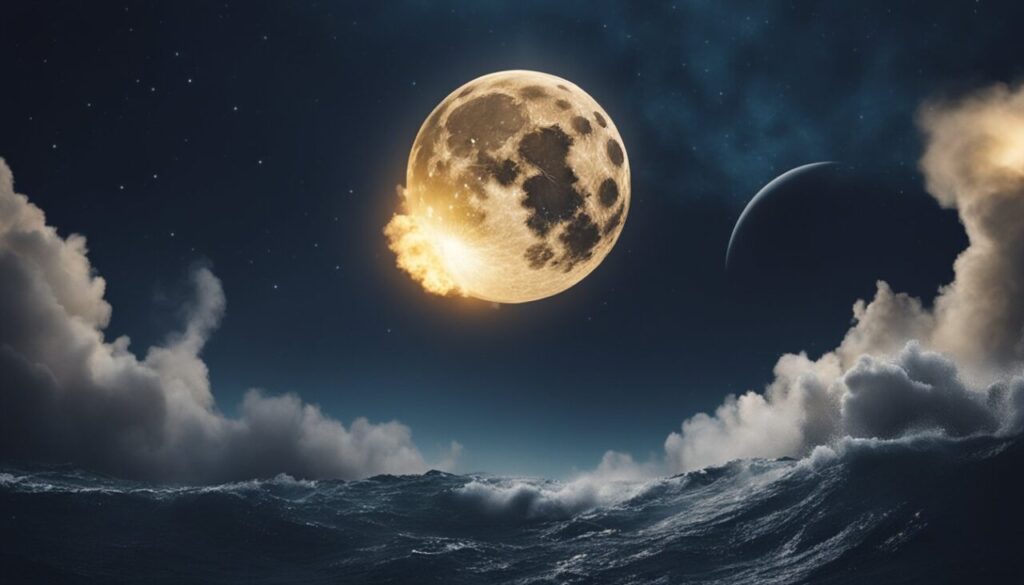
Let’s just state the following: energy released from the impact would be equivalent to billions of atomic bombs exploding at once. If not more. The immediate effects of the impact would be devastating.
The force of the collision would cause a massive shock wave to spread out from the point of impact, destroying everything in its path. The impact would also generate a massive amount of heat, causing widespread fires and burning everything in its vicinity.
The impact would also cause the Earth’s crust to buckle and fracture, creating massive rifts and fissures in the ground. This would release huge amounts of magma and toxic gases into the atmosphere, creating a deadly environment for all living things.
So the simple answer is – yes everything would most likely die. Well, to be exact – everything that we consider as living beings. Some bacteria and other extremophiles would perhaps survive as they are capable of living in extreme environments and are highly adaptable.
Okay, and so now that we know that everything and everyone would die most likely, let’s see what would happen in a timeline; starting from 1 second and ending in quintillion years from collision.
Interesting fact: The impact of the moon crashing into the Earth would be so powerful that it would be felt throughout the entire solar system.
Timeline of Moon Collision With Earth
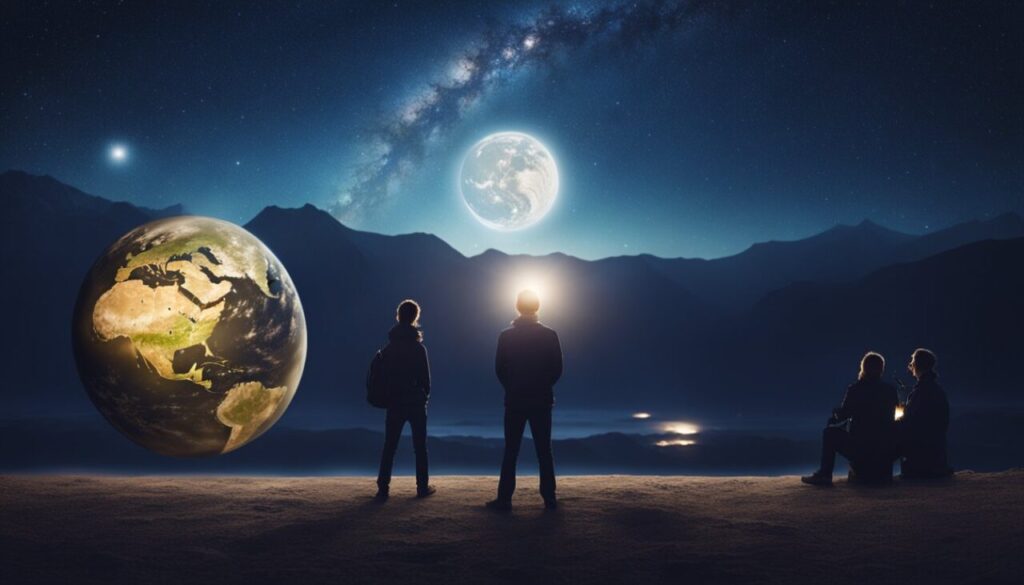
First Seconds
In the first few seconds of a hypothetical collision between the Moon and Earth, the impact would cause a massive shockwave that would travel through the Earth’s crust, causing earthquakes and volcanic eruptions. The debris from the collision would be thrown into space, and the Moon would likely break apart into smaller pieces.
One Hour
Within an hour of the collision, the debris from the impact would start to fall back to Earth, causing additional damage. By now, most living beings on Earth would be dead. Earth would most likely stay as it is, meaning it would not break apart completely. Similarly, as we explained in our article “What If Theia Never Hit The Earth?”
One Day
Within a day of the collision, the Earth’s climate would be drastically altered. The global cooling effect caused by the dust and debris in the atmosphere would lead to a significant drop in temperature.
The impact would also cause a shift in the Earth’s axis, leading to changes in the length of the day and the seasons.
One Year
Within a year of the collision, Earth would still most likely be in complete chaos. The dust and debris in the atmosphere would continue to block out the sun, causing a prolonged period of global cooling.
100 Years After Collision
After 100 years, the Earth’s climate would most likely start to stabilize, and the dust and debris in the atmosphere would have mostly cleared. However, the impact would have caused permanent changes to the Earth’s surface and the overall behavior of the planet. The planet would still be uninhabitable.
Interesting fact: The crater left by the impact would be visible from space and would be one of the largest features on the Earth's surface.
100 Million Years After Collision
After 100 million years, the Earth could potentially regain its habitability. Days and nights would look completely different and time would be measured differently. Debris from the impact would have already assimilated into another moon.
This time, the moon would be much smaller, hence impacting the Earth’s climate in a different way. Similarly, as we explained in our articles: “What Would Happen If The Moon Exploded” and “What Would Happen If Moon Disappeared”.
Still no homo sapiens. That is, of course, if we presume that we all died minutes and hours after the collision.
One Billion Years After Collision
After one billion years, the Earth’s surface would have completely recovered from the impact, and the original Moon’s absence would have become a distant memory. However, as mentioned because of debris created during a crash, we’d most likely still have another but much smaller moon.
Additionally, with or without a crash happening, in one billion years Earth would become an uninhabitable planet. This is because the sun’s luminosity is projected to increase by 10%, leading to the onset of a “moist greenhouse” effect in the atmosphere.
This phenomenon will trigger a rapid evaporation of the oceans, potentially halting plate tectonics and disrupting the carbon cycle.
Needless to say, the temperature on Earth will increase to the point where it is uninhabitable for every living being.
Quintillion Years After Collision
After a quintillion years, the Sun would have already entered its red giant phase, and the Earth-Moon hybrid would have been swallowed up by the expanding star.
As mentioned in our article “What Will Happen in Quintillion Years From Now,” regardless of the collision of the Moon and Earth quintillion years ago, none would exist anymore, as the Universe will enter the stage of almost nothingness filled mostly with black holes.
Interesting fact: The merger of the Earth and Moon would have probably created a new type of celestial object, known as a "synestia".
Conclusion

In conclusion, if the moon were to crash into Earth, it would have catastrophic consequences for all life on our planet. The impact would cause massive earthquakes, tsunamis, and volcanic eruptions.
The debris from the collision would be ejected into space and could potentially rain down on Earth, causing further destruction. The loss of the moon would also have long-term effects on Earth’s climate and tides.
The moon’s gravitational pull is responsible for the tides, and without it, the oceans would become stagnant and lifeless.
Additionally, the moon helps stabilize Earth’s axial tilt, which is responsible for our planet’s seasons. Without the moon, Earth’s tilt would become unstable, leading to extreme climate changes.
In the end, without further philosophy and additional hypotheses – in the ultra-unlikely event of the moon crashing into Earth everything would be destroyed.
All living beings would die off, eventually leaving the planets with some bacteria and other extremophiles.





















